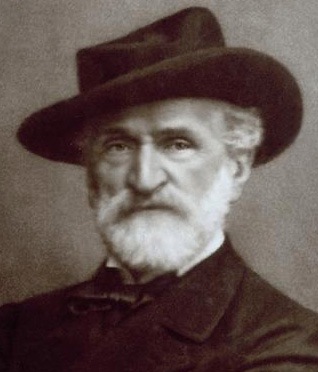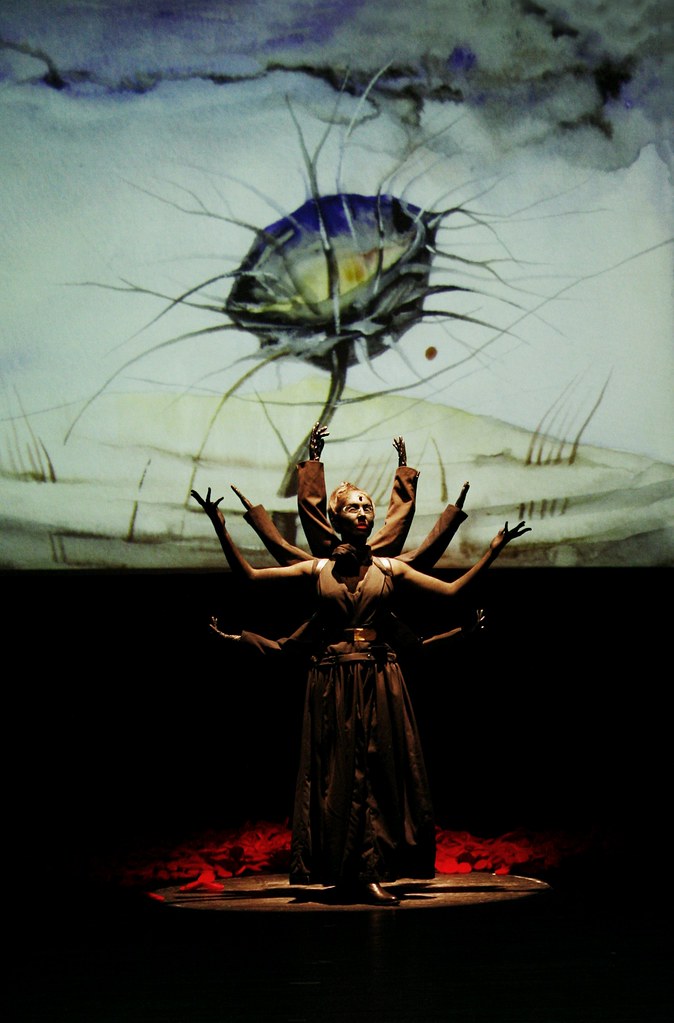 |
| Giacomo Brogi (1822-1881), Portrait of Giuseppe Verdi (Photo credit: Wikipedia) |
The same year, he experienced another blow: his beloved sister Josephine died. And in 1837, another misfortune found him. From his marriage to Margherita Barezzi in 1836, he had a daughter, Virginia, whom he adored. But Virginia died when she was only a few months old. In a dispirited condition, Verdi isolated himself in his home, in Milan, and faced tremendous difficulties: he was jobless, had no money, and often could only eat once a day in miserable inns. As if all that were not enough, in 1839 his second child -a young son- also died. Verdi's life became unbearable. In 1840, he received the most tragic blow of all: his beloved wife, Margherita Barezzi, died. Grief-stricken, Verdi fled Milan for his village Busseto, so that he could find solace.
But impresario Merelli visited him there and asked him whether he would like to compose the music for a work titled Nabuchodonosor. Verdi of course, refused. He had lost his desire to compose music. Merelli insisted, however, putting the libretto for that work in Verdi's pocket. With half heart, he tried later to start composing. But the notes weren't appearing -or if they were, they were full of sorrow, like the composer's soul.
However, he finished it in 1841. Rehearsals on the opera Nabuchodonosor -or Nabucco as it turned to be named in the meantime- started early in 1842. But immediately it became clear that Verdi had composed a masterpiece. Nabucco was performed for the first time in La Scala in Milan on March 9, 1842. What followed was an unprecedented triumph. The enraptured audience responded with a standing ovation, demanding -with a frenzy of applause- repeated encores of the moving chorus song "Va, pensiero, sull' ali dorate," which still causes shivers of emotion.
Verdi -now 29- had suddenly become famous. People were singing the chorus song from Nabucco in the streets, while hats and neckties with Verdi's name inscribed on them were sold everywhere. Milan's wealthiest families opened their homes to him. The same year (1842), the composer became acquainted with a famous soprano, Josephina Strepponi, and developed a lasting relationship with her that persisted until her death in 1897.
During the next nine years, between 1843 and 1851, Verdi composed thirteen operas, which were performed in all the big cities of Italy -Milan, Rome, Venice, Naples, Trieste- as well as in London, and all had enormous success. The first of those operas was I Lombardi, which was performed at La Scala in Milan on February 11, 1843. The day of its premiere, enthusiastic crowds mobbed the theater, and the success of that opera was similar to Nabucco.
Opera Ernani followed in 1844, based on Victor Hugo's work of the same name. It premiered in Venice on March 9, 1844, to great acclaim. Exuberant Venetians lifted Verdi to their shoulders and carried him triumphantly around Saint Mark's square. With the money he earned from Ernani, Verdi was able to buy a small farm near his village. Opera Jeanne d' Arc (Giovanna d' Arco) followed in 1845, with equally great success. Verdi had now so much money that he acquired a mansion in his village Busseto.
Other accomplishments included the operas Attila in 1846, and I Masnadieri (The Bandits) in 1847. The Bandits' premiere was held in London with a particular fanfare: Queen Victoria and almost all the members of Parliament were present. The opera was a big hit, and Verdi made staggering amounts of money. He bought a large farm with woods and vineyards near Busseto, and an apartment in Paris, where he retreated from time to time to relax with his companion, Josephina Strepponi.
The tension between Italy and Austria was mounting in this period, and to stir up patriotic sentiments, Verdi composed the opera La Battaglia di Legnano (The Battle of Legnano). That opera was first performed in Rome in 1849. Tickets for the premiere were sold out. It was another smash hit. Ecstatic, the audience demanded as an encore the repetition of the entire fourth act. Verdi had become a national hero. At the end of the same year, a Verdi opera was performed in Naples, too: Luisa Miller, based on Schiller's tragedy of the same name.
During the next eight years (1851-1859), Verdi composed his extraordinary masterpieces, the operas Rigoletto, Il Trovatore, La Traviata, Les Vêpres Siciliennes, Simon Boccanegra, Un Ballo in Maschera, and others -and he arrived at the culmination of his glory. He finished the first of those masterpieces, Rigoletto, early in 1851, and its premiere was staged in Venice on March 11 of the same year. All night, Venice's canals resounded with the voices of gondoliers' singing "Feather in the Wind," a song well known even now. After 21 performances in Venice, Rigoletto began to be performed all over the world.
In 1851, Verdi also began to compose his next masterpiece, the opera Il Trovatore, which he completed the following year. The premiere was held in Rome in January 1853, again to great acclaim. Two months later, his third masterpiece - the opera La Traviata- premiered in Venice. It was again an instant hit and was even performed in America.
In 1855, Verdi finished the opera Les Vêpres Siciliennes. Its premiere was held in L' Opera de Paris; in 1856 it was performed in La Scala in Milan with tremendous success. Its ardent patriotism stirred the souls of Italians. In 1857, the opera Simon Boccanegra was performed in Venice, and the same year, Verdi composed the opera Un Ballo in Maschera. The latter opera was performed in Rome in February 1859 with great success -the ticket prices were seven times normal.
Verdi had arrived at the pinnacle of his career; at the age of 46, he was considered Europe's greatest composer. To make his success complete, he married early 1859 the woman with whom he had lived for the last 17 years, Josephina Strepponi.
In the next years, Verdi composed a lot of other operas. In 1862, he finished his work La Forza del Destino (The Power of Destiny), which the Russian Theater of Petrograd had commissioned. In March 1867, the opera Don Carlos was performed for the first time in Paris. At the end of 1871, his opera Aida was performed in Cairo. The performance lasted more than eight hours -from 7:00 p.m. to 3.00 a.m.
In 1874, he expressed his feelings in his next work, the mournful Messa da Requiem, performed in May 1874 in the church of St. Mark in Milan. Next year, sorrowful da Requiem realized enormous success. After having conquered all of Italy, it did the same in the rest of Europe, while in London an unbelievable chorus of 1,200 voices would participate in the performance, a fact that moved the critics to write rave reviews.
Verdi -now aged 62-began to enjoy the delights of life. He became acquainted with a young intellectual, Arrigo Boito, who shared the pleasures of culture with him, exposing him to the new intellectual currents and fashions. In 1876, Verdi conducted his opera Aida in Paris, and soon the opera was performed triumphantly all over Europe. In 1881 he rewrote his opera Simon Boccanegra, which was performed that same year in its new form with great success.
From 1879, he had started setting the music for Shakespeare's Otello, which he finally finished in 1886. The premiere took place at La Scala in 1887. Celebrities from all over Europe arrived for the performance, and tickets prices reached unprecedented heights. At the end of the performance, the audience's cries of joy could be heard blocks away. When Verdi came out of the theater overcome with emotion, the people unhitched the horses of his carriage and drew it themselves to his hotel. Between 1888 and 1892, Verdi composed another masterpiece, the opera Falstaff, again based on Shakespeare. Falstaff was performed in La Scala in 1894.
In 1897, Verdi's beloved companion, his wife Josephina Strepponi, died. From then on, his health crumbled, and the year 1900 found him confined to a wheelchair. In 1901, the great composer -one of the greatest in the world- departed from this life, at the age of 88.
Conclusion
Verdi's life reveals that sometimes grief can lead to enormous success. As you can recall, when Verdi was 24, in 1837, his beloved daughter Virginia died, and two years later, his second child also died. Next year, in 1840, his beloved wife Margherita Barezzi died, too. Grief-stricken, he fled Milan for his village. But impresario Merelli visited him there and asked him to compose the music for the opera Nabucco. Verdi refused, but later he started composing, though he was full of sorrow. The outcome was a masterpiece. When Nabucco was performed, it was an unprecedented success. Grief had led to triumph. From now on, Verdi became one of the greatest composers in the world.
On the subject of this article I have written a whole book titled The Seasons of Our Lives, in which I explain how our life's seasons alternate from good to bad -and vice versa- based on the way the good and bad seasons have alternated in the lives of lots of famous men and women, whose the biographies I cite in the book (Verdi's included).
The moment you have finished reading this book, you will be able to know whether the years just ahead are good or bad for you, and how long this season will last. You will be able thus to act accordingly: if there is a storm on the horizon, you will take shelter in time. If sunny days loom ahead, you will take advantage before the opportunity passes. The book is published by Heart Space Publications, an Australian publisher, and you can find it at Amazon under the words: The Seasons of Our Lives Kouloukis paperback, or at my website: http://www.gpkouloukis.com.
George Kouloukis is a Greek attorney-at-law, a barrister. As a member of the Athens Bar Association, he has offered legal services to Ionian Bank of Greece, the Greek Electric Railways Company, and other corporations. Article Source: EzineArticles |















